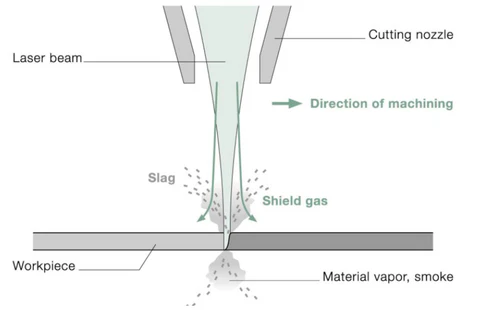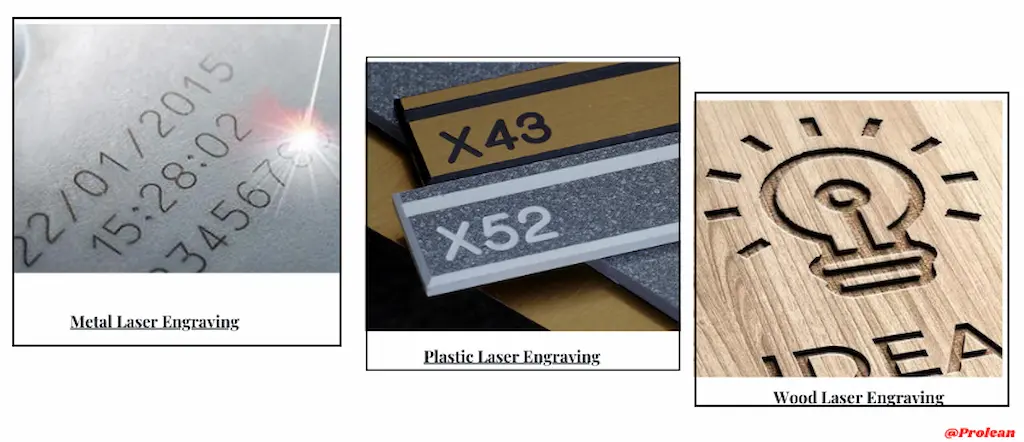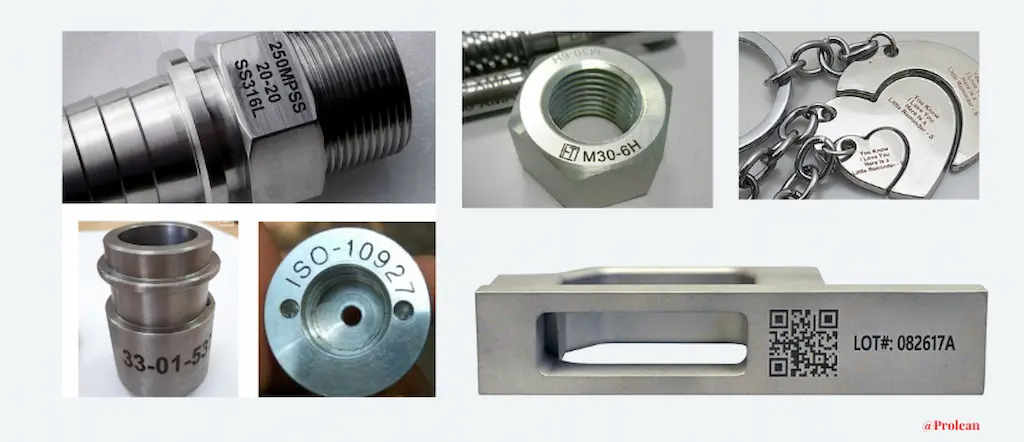“Laser engraves logos, part numbers, or patterns on various materials while maintaining aesthetic appeal.”

Engraving is the best method to create signs, logos, texts, patterns, and letters on the work surfaces. Different methods of engraving are used in manufacturing, mechanical engraving, etching, laser engraving, etc. The laser engraving method is especially popular for metallic workpieces across various applications. A laser beam strikes the work and selectively vaporizes the material to engrave the surface. Meanwhile, the use of CNC lasers provides a higher level of accuracy and precision.
Understanding the engraving concept, techniques, types, and other aspects helps to make better decisions and achieve optimal results. This article will discuss the working mechanism, compatible materials, applications, etc.
What is Laser Engraving?
It is the process of creating deep permanent marks on the material surface by non-contacting (no-shear) material removal. The laser engraving uses CO₂ or fiber laser sources that precisely move along a specified path or pattern melting & vaporizing the material at a certain depth. The type of laser source depends on the material type, CO₂ is suitable for metal engraving and fiber for non-metallic workpieces.
The history of engraving is predicted to be 500,000 years back, at the beginning of the stone stage. It is believed that people used to engrave signs with stones at that time. Later on, it becomes one of the key technologies of civilization with the start of the Metal Age. Till the Early 1900, mechanical engraving was popular everywhere, from coins (currency) to industrial items.
In 1950, laser engraving was first used in aircraft manufacturing following the laser technology thesis of Albert Einestines presented in the late 1910s. However, the first commercial machine was introduced into the market only after the 1960s. Then, this technology is continuously evolving its capabilities over time.
At present, you can see the permanent branding logos, signs, patterns, designed text and letters, craft, and features in various metallic and non-metallic products, engraving chassis numbers in vehicles to designs in jewelry items. These are engraved with laser for precision, accuracy, and durability.
Try Prolean Now!
How Laser Engraving Works?
As we mentioned above shortly regarding how laser engraving works, a laser beam makes an impact on the workpiece, and intense heat melts the materials to form the engraving features. However, the setup and detailed process is much more comprehensive than it sounds.

Working of laser engraving
A CNC laser engraver setup involves two or more mirrors( typically three) than a focusing length to concentrate the beam before it comes from the laser head. So, the beam from the low-powered laser source goes in to focus the lens after reflecting through multiple mirrors. The CNC program dictates the movement and striking of laser beams and delivers a high level of precision, as low as 0.004 inches.
The system operates along the X, Y, and Z axes, ensuring accurate and detailed engraving by controlling the movement of the laser head and the workpiece positioning. Meanwhile, the power of the laser source, speed, focal length, and number of times the laser beam passes decides the engraving depth. You can set these variables in the machine. Furthermore, compressed air is applied during engraving to remove debris and prevent lens contamination.
For a better illustration of how laser graving works, let’s look a the steps of the engraving process;
Steps of the Laser Engraving Process
The process involves engraving the CAD design by converting that into machine-readable instructions called vector files. The following steps elaborate on how you can engrave material with a laser;
- Designing
The first step is designing engraving features on computer software like AutoCAD, Linkspace, LigthBurn, etc. The design must illustrate the shape, size, depth, tolerances, and other technical information.
- Design to Instructions
Next, the laser engraver machine converts this design into instructions for laser head movement, called raster or Vector files. These instructions include laser path, beam repetition, speed, etc.
- Material Preparation
The workpiece must be thoroughly cleaned without any debris, contaminations, or burrs. Next, you also need to consider the material capabilities of available machinery. Some lasers can only work with specific materials.
- Machine Setup
The setup for the laser engraving process typically involves, work clapping, laser configuration, and alignment. Engraving variables like speed, source power, frequency, and focal length should be optimized based on your requirements. You can also run the test on scrap workpieces before starting the actual process.
- Engraving
Now, the laser head moves in the pre-determined path with multiple passes following the instructions from the machine. This automation reduces the downtime, enhances the precision, and makes the process more cost-effective.
Are Laser Engraving and Laser Marking the Same Processes?

Laser engraving vs etching vs marking
Although both processes use similar laser sources and setups, the laser marking does not involve the material removal and creation of patterns or shapes on the surface with the cavities. Instead, the laser permanently discolors the surface in a designed pattern in the laser marking process. Every material has a unique laser absorption spectrum, which changes itself into different colors after interacting with the laser. Color spectrum can show different responses according to the laser source, rated power, and wavelengths. You can also create laser engraving logo, QR codes, and signage.
So, you can consider laser engraving as one of the laser marking types in terms of applications, but they are essentially not the same process.
Laser Engraving Materials

Common laser engraving materials
A laser can engrave metal, plastic, leather, composites, wood, and fabric. However, the laser type and processing variables are different for them. This is because distinct laser engraving materials react with laser beams uniquely. For instance, the low melting points of plastics tend to show more thermal effects than metals.
Metal is engraved with fiber laser sources for better results, whereas CO₂ is popular for wood. Meanwhile, plastics can be engraved with both CO₂ and fiber. Unlike conventional techniques, it can even engrave hard materials with any level of complexity.
Metals
Almost all metals and alloys are compatible with the laser engraving process, and they are the most used material for engraving. The right laser power can process them effectively from soft aluminum to hardened steel.
- Stainless Steel
- Aluminum
- Brass
- Copper
- Titanium
- Gold
- Silver
- Anodized Aluminum
- Nickel
- Chrome, etc.
Plastics
Thermosets and thermoplastics can both be engraved with a laser. Moreover, acrylic laser engraving is the most popular due to its strength, impact resistance, and durability, from signage to display boards. Next, thicker plastics are more challenging than laser engraving metal as surrounding plastic material accumulates heat and affects accuracy.
- Acrylic
- ABS (Acrylonitrile Butadiene Styrene)
- Polycarbonate
- Polyethylene (PE)
- Nylon
- Delrin (Acetal), etc.
Wood
Various art, crafts, patterns, decorative items, and even jewelry are made with wood laser engraving. The low power (typically <100) can precisely burn and erode the wood surface at the desired depth. Meanwhile, walnut and maple are two highly suitable woods for this process.
Other Laser Engraving Materials
Besides, wood, metal, alloys, and plastics, other laser engraving materials are;
- Carbon fiber, glass, kevlar reinforced polymer
- Silicone rubber
- Genuine, synthetic, and suede leather
- Cardstock
Try Prolean Now!
What Are the Types of Laser Engraving?
The classification can be done with two bases; lasing medium and specific application. Let’s discuss different types of laser engraving under these two classifications;
Based On the Laser Source
It means what is the light source for the laser; often also considered as the types of engraving machines. Manufacturers also define engraving machines by the type of laser source used in the machine.
CO₂ Laser Engraving
It uses CO₂ as a lasing medium, and an infrared beam emerges from this gas with a wavelength of 10.6 micrometers. A CO₂ laser works with non-metallic laser engraving materials like acrylic, wood, rubber, and, glass, leather, etc.
Fiber Laser Engraving
A special fiber optic cable that is doped with rare earth elements like erbium or ytterbium is used in fiber lasers as the active medium. It is highly efficient, compact, and ideal for precision metal engraving. It offers high-speed engraving and is compatible with hard alloys. But, it has minimal uses in non-metallic engraving. The fiber lasers can be expensive and require open or ventilated workspace to eliminate the risk of fumes or gases.
Diode Laser
As the name suggested, it uses semiconductor diodes as the lasing medium. When electricity passes through the diode, it emits laser light further concentrated into a focal lens before striking into the workpiece surface.
The diode lasers are suitable for small-size engraving and the engraves also come in the form of Desktop or Portable machines. It produces the engraved surface smooth similar to fiber lasers. However, diode lasers have limited capability for large and deep engraving.
Furthermore, UV and ND: YAG LASERS are also used for engraving tasks.
Based on Laser Engraving Features
Relief, deep, picture, or other featured-based classification for types of laser engraving. The table below briefly elaborates the characteristics of those types;
| Engraving Type | Description | Depth/Effect | Materials |
| Shallow Engraving |
– Less than 0.5mm depth – Low laser power lighter color |
Lower power & shallow effect | All thin engravable materials |
| Deep Engraving |
– More than 0.5mm depth – Darker color – Higher power required |
Stronger contrast and deep effect | Materials > 2mm thickness |
| Relief Engraving |
– Variable depth – 3D effect – It uses a grayscale image |
Three-dimensional texture | Thick materials |
| Vector Engraving |
– Lines and Points engraving – Based on vector graphics |
Clean and precise line engraving | Any material |
| Photo Engraving |
– Based on photographs – It involves image processing |
Detailed, image-based engraving | Requires high-resolution photos |
What Are the Advantages of Laser Engraving?
Engraving with laser does not involve the physical contact between the tool and material, although thermal effects can be more. It eliminates the risk of shear deformation and inaccuracy due to tool wear. Furthermore, other key benefits are;
- Highly Precise and Accurate Engraved Features
Whatever techniques or methods we described above, the laser engraving process provides higher precision and accuracy. The advanced CNC and automated laser engravers achieve tight tolerance compared to conventional engraving or laser-making techniques.
- Engraving Speed
The high laser engraving speed increases production efficiency and reduces the per-unit manufacturing cost. It is also beneficial for industries or businesses that require a quick turnaround.
- Compatible with Diverse Materials
It engraves metals, wood, plastics, composites, glass, rubber, leather, and fabric with the right laser machine and precise power control.
- Simple Operations
Compared to mechanical engraving and other laser machining techniques, it is a more simple process. The laser head follows the path and engraves the desired designs.
- Clean Narrow Patterns
Laser produces a burr-free clean engraved surface, including hard materials and narrow designs.
- Durability
The laser-engraved components last for several years and the engraving does not fade away over time. So, it is a reliable solution.
What Are the Laser Engraving Applications?

Laser engraving applications
Trophies, signages, barcodes, business brands, identification numbers, assembly directions, and many other engravings are done with lasers. So, it has diverse industrial applications.
Trophies Engraving
In both metallic and non-metallic trophies, laser engraves attractive symbols, logos, letters, and other information in wood, glass, or metal trophies. You can use it for simple to highly intricate and custom trophies, awards, and medals.
Brand Logos and Symbols
The burr-free precise engraving of laser has made it popular in various industrial items to create brand symbols, marks, and symbols. The application ranges from vehicle brand logos to leather clothing.
- Engraving vehicles brands name, symbol, and logos
- Logos of electronics brands, laptops, tablets, smartphones, electrical enclosures, etc.
- Luxury jewelry brand logos
- Packaging and promotional items
QR and Barcodes
The permanent barcode and QR on acrylic, glass, and metals for diverse purposes, whether a QR for small businesses or information Barcodes in industrial components. The reason why a laser is ideal for engraving these codes is that it can precisely replicate the pattern and last for a longer time without fading.
Medical Device and Components
Medical devices and components need clear identification numbers or lettering for their safe and effective operations. Laser can engrave these even in small components with minimal process effects, such as deformation.
Die and Molds
Laser engraving applications also have an essential role in creating complex features like tiny cavities, grooves, or other features. Lase can also make features on mold or die if the final part needs embossed symbols, lettering, or numbers.
Read more: What is laser marking on plastic extrusion?
Do You Need Custom Laser Engraving Parts?
At ProleanTech we deliver the laser engraving service combining advanced laser engraver machines( CO₂, fiber, diode, etc.), the experience of our engineers, and an in-depth understanding of requirements from clients. We can customize custom engraved designs on 200 + engineered materials. So if you need accurate logos, signage, QR Codes, numbers & letters, creative arts, jewelry, or any of your custom designs, upload your design and request a quote!
Try Prolean Now!
Conclusion
Overall, laser engraving is an essential technology in various industrial, art, advertising, and jewelry applications. The material diversity, precise control, accuracy, and capabilities of replicating complex designs are the main reasons why it can give optimal results for your engraved parts or products. So, whatever material or product, you can use laser for permanent, custom, and attractive graving.
FAQs
Can I use any type of laser engraving machine for my project?
Your choice of laser engraving machine type depends on the workpiece material. CO₂ laser is suitable for non-metallic engraving and fiber lasers are ideal for metallic engraving. Meanwhile, diode lasers perform small engraving tasks efficiently.
How to adjust the engraving laser head?
The focal length between the laser lens and the workpiece surface decides the positioning of the laser head. So, use a focusing tool or follow the manufacturer’s guidelines to position the laser head accurately.
Which materials are possible to engrave with the laser beam?
Lasers can engrave metal, alloys, composites, thermoplastics, thermosets, rubber, fabric, and leather; based on their absorption properties.
Why use laser for engraving signs, logos, and QR codes?
It is a non-contact material removal process that creates high-resolution permanent signs, logos, and QR codes on diverse materials.




0 Comments